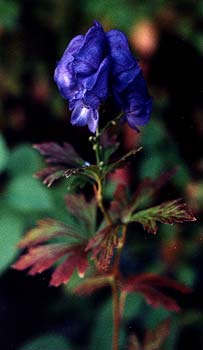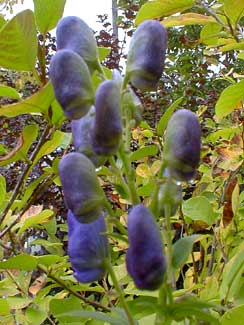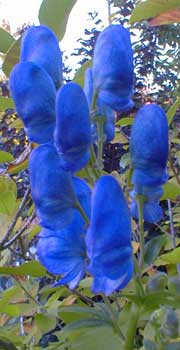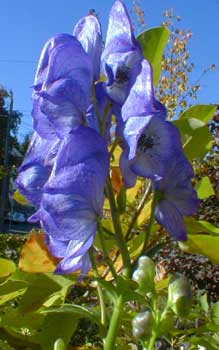
Azure Monkshood,
aka, Carmichael's Monkshood
aka, Fischer's Chinese Wolfsbane
aka, Sichuan Aconite,
aka, September Stormhat,
aka, Wu Tou
"A cluster of aconite mixt with weeds entwining!"
-Laurence Binyon.
1869-1943
1869-1943
We have scads of monkshoods throughout our gardens, one of which is shaded by evergreen huckleberries & Oyama magnolia, & encroached upon by a nearby aggressive old fashioned bleedinghearts that spreads wide from under the Oyama.
Aconitum carmichaeli is the Azure or Chinese Monkshood. It was formerly called A. fischeri after Friedrich Ernst Ludwig Fischer (1782‚1854), who was the director of the botanic garden in St. Petersburg. The present species name is after Dugald Carmichael (1772‚1827), a sea captain born on the Isle of Lismore, Scotland, & who was most knowledgeable in botany, geology & ichthyology.
An 1898 medical text, King's American Dispensary, mistakenly identified a common Rocky Mountain native monkshood as A. fischeri, & dubbed it American Aconite. But that classic text failed to recognize A. columbianum as a distinct species, & Fischer's, Carmichael's, or Azure Monkshood's extensive range does not include North America. It grows in temperate regions of northern Japan, China, & eastern Russia, & is called Wu Tou in China.
It flowers deep blue in September & October, the last monkshoods to bloom. The flowers occasionally tend to bunch up near the top of the spike, sometimes nearly forming a "ball" of cowled flowers facing every direction. In our garden its leaves have had an attractive reddish brown autumn coloration in October well before it shows any signs of dying back for winter; the first October 2002 photo at top shows some of this coloration This is a bit different from the other monkshoods that merely die back without first gaining interesting leaf color.
 Azure Monkshood is one of the more poisonous species, probably the equal of the European variety. But it is claimed that it has been so very long cultivated in China that several gardened strains through a millenium of selectivity are today less toxic, so that its toxins have been usable in Chinese herbal medicine with reduced risk. This is highly doubtful. A Hong Kong study has shown that people seeking Chinese herbal doctors are frequently injured by prescriptions, & the two herbal remedies most apt to result in cardiovascular arrest are Cao Wu & Chuan Wu. These are respectively derived primarily from wild-gathered A. kusnezoffi & from cultivated A. carmichaeli.
Azure Monkshood is one of the more poisonous species, probably the equal of the European variety. But it is claimed that it has been so very long cultivated in China that several gardened strains through a millenium of selectivity are today less toxic, so that its toxins have been usable in Chinese herbal medicine with reduced risk. This is highly doubtful. A Hong Kong study has shown that people seeking Chinese herbal doctors are frequently injured by prescriptions, & the two herbal remedies most apt to result in cardiovascular arrest are Cao Wu & Chuan Wu. These are respectively derived primarily from wild-gathered A. kusnezoffi & from cultivated A. carmichaeli.With the second, third, & fourth photos from September 2003, I've tried to show the progression of color as the blooms mature. The second photo at mid-September shows the swollen buds just before they open. At this stage the backs of the closed hoods are grey & the fronts are pale blue.
 But a week later, as shown in the third photo, the hoods are still mostly closed in front, but swollen in size, & a fantastically vibrant blue with an almost metallic sheen. I was so happy this look came out pretty well in the third photo, as the sheen is hard to capture with a digital camera. A few days further along, the hoods are fully opened, revealing their creamy white interiors; & the hood is a paler blue.
But a week later, as shown in the third photo, the hoods are still mostly closed in front, but swollen in size, & a fantastically vibrant blue with an almost metallic sheen. I was so happy this look came out pretty well in the third photo, as the sheen is hard to capture with a digital camera. A few days further along, the hoods are fully opened, revealing their creamy white interiors; & the hood is a paler blue.In 2004 the blooms came a bit later, & were at their height in October, with many more spikes of flowers than for the first year, growth-rate being more rapid than any other monkshood we have.
In its shady location in our garden, it is the first of our many aconites to return after their winter die-back, despite that it is late to bloom. The basal leaves are already returning by mid-January, getting a good long jump on spring, though the clump doesn't achieve its full size until May. The primary leafy clump grows two to three feet high, plus leafed spikes of flowers extending the height to no less than four feet on most specimens, but ours reaches seven feet, as it wants to reach above the surrounding shrubbery, lifting its flower-heads above the huckleberries into a bit more sun. We have a cultivar of this speces, 'Arendsii.' that stays smaller.
 When young, though the tallest stems sometimes lean a bit, it does so in a sturdy rather than weak manner, looking devil-may-care. Elsetimes it stands extremely upright. But an old clump can be so very tall & topheavy for flowers that it does tip. Ours has never needed staking, but that's mainly because it manages to lean into the branches of the fountaining Oyama magnolia & never tips too much to become unappealing. The much smaller clump of basal leaves, however, can be weak & floppy, & occasionally a bit creeper-like, & when not flowering has something of the effect of a crane's-bill but with way bigger leaves.
When young, though the tallest stems sometimes lean a bit, it does so in a sturdy rather than weak manner, looking devil-may-care. Elsetimes it stands extremely upright. But an old clump can be so very tall & topheavy for flowers that it does tip. Ours has never needed staking, but that's mainly because it manages to lean into the branches of the fountaining Oyama magnolia & never tips too much to become unappealing. The much smaller clump of basal leaves, however, can be weak & floppy, & occasionally a bit creeper-like, & when not flowering has something of the effect of a crane's-bill but with way bigger leaves.Though monkshood is banned for internal use in the United States, & Chinese herbs derived from it cannot legally be imported, there have nevertheless been cases of its illegal importation under the less easily recognized label "Rhizome Carmichaeli." So hypochondriacs with alternative medicine addictions should be wary whenever consulting their favorite vaunted & over-romanticized Chinese quack, whose concoctions frequently include mercury, aconite, or diabetes medicines mixed into them as the actual "active" & extremely dangerous ingredients. Or western homeopathists for that matter, many of whom seem constitutionally incapable of of plying their dubious trade within the strictures of troublesome public health laws, have been known to adapt legally obtained garden specimens to their magical system which preposterously claims to reverse the effects of deadly toxins by using poisonous plants to treat the sorts of ailments the toxins cause.
Most monkshoods have a little trouble "bouncing back" from being dug up & divided, as their substantial root systems do not like being disturbed. But A. carmichaeli having been so long cultivated in China it is reputedly more amenable to being divided every few years, preferably in autumn or winter because it is already growing back by spring & will by then resent being disturbed. This feature is perhaps debatable, & I wouldn't divide it unless it had gotten burdensomely large or had weaker blossoms after five or six years.
It is certainly one of the hardiest species in this hardy genus, asking only a little protection from harsh sun, & requiring consistent moisture. Highly adaptable as to soil conditions, it grows in clayey soils, sandy soils, & loamy soils. A moderately loamy soil is likely its favorite & it will flower best in autumn if not subjected to too droughty a summer.
As is true of other monkshoods & delphiniums, Azure Monkshood can inhibit the growth of nearby plants. This is especially so with legumes. Yet the majority of plants will thrive near monkshoods.
Aconitum carmichaelii 'Arendsii'